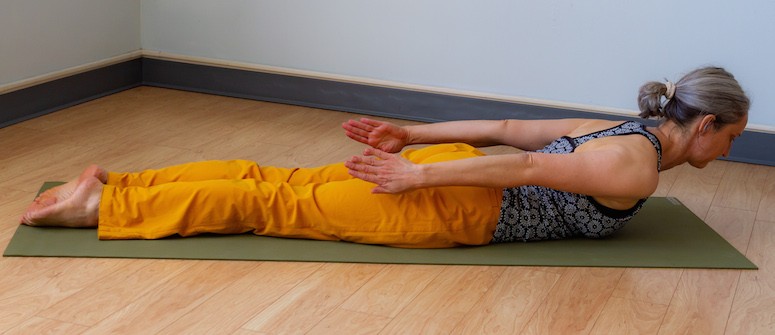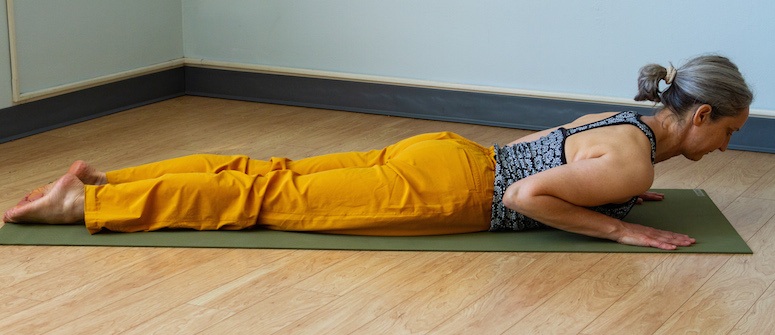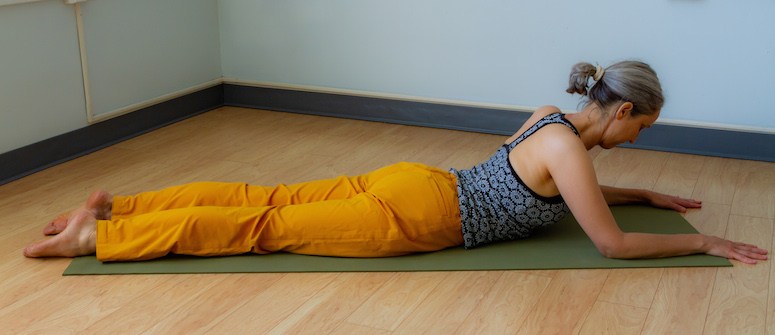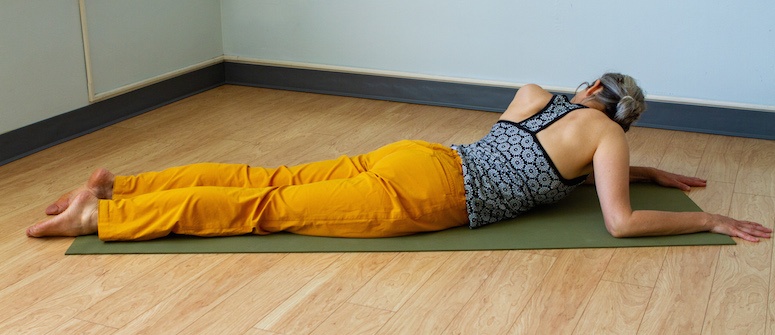“Ya look like a gnome,” my ballet teacher said to me in her nasal New York accent in front of the whole class. She was referring to my rounded upper spine, which I couldn’t straighten even though I was in my early 20s. In response, I saw a chiropractor and got lessons in the Alexander Technique®, which promotes ease in standing, sitting, and walking. These helped some, but I made the most progress when I practiced variations of asanas to target upper spine mobility. This happened in my late 40s, so if you are thinking it’s too late, think again!
The Anatomy of Slumping
The vertebrae of the spine are separated by intervertebral discs and enveloped by a complex weaving of muscles, tendons, and ligaments; visceral fascia attaches at the front. All of these soft tissues elongate or shorten depending on the movement of the vertebrae, adhesions in the fascia, and our energy level and mood. When we are enthusiastic, there is an upward energy which activates muscles along the spine, facilitating optimum alignment of the vertebrae. When we slump habitually, there is less space between the vertebrae in front and more space in the back: thus intervertebral discs lose their plumpness in the front. Also, the muscles and fascia in the front of the torso shorten, while in the back they overstretch.
I suspect that the shapes of our vertebrae also change as our posture changes, though there are no studies confirming this. According to Wolff’s law of bone formation, bones change shape to adapt to the stresses that are placed on them. Years of slumping may change the shapes of the vertebrae; perhaps that is why this postural habit is difficult to change and why, when we try to straighten after years of slumping, it feels like we are fighting against our history.
A New Perspective

In order to work toward spinal health, we need an idea of what healthy upper spine alignment looks like. Esther Gokhale, a pioneer in the teaching of posture, discovered that people from cultures that have no back pain have a flattened upper spine: instead of a spinal “S” curve (a convex curve in the lumbar spine and a concave curve in the upper, or thoracic, spine), they have what she calls a “J” curve (less of a thoracic curve, with the lumbar curve occurring at the base of the lower back only).
We start our lives this way: check out the posture of young children, and you will see what I mean. We lose our J curve because we stop moving like children. Children explore the world with enthusiasm in all directions, while we adults limit our movements to walking and to forward-bending tasks like texting, driving, housecleaning, and gardening. Mostly, we sit. I think regaining a J curve in the spine is key to keeping us young. And movement is essential.
Body-Mind Connection

Movement helps the soft tissues: flexing, arching, twisting, and sidebending hydrate the discs while equalizing the tension in the muscles, ligaments, and tendons between the front and back of the body. Yet after moving my spine in all these directions in dance, I was still hunched over. Why? In hindsight, I am sure that when I did backward-bending movements, I only arched my lower back and neck, and not my upper spine. My upper back was out of my awareness: I couldn’t move it because I couldn’t feel it. There was a reason I needed to keep my heart protected at that time. I notice this with clients, also: the shift in posture or in our well-being comes when we are ready to acknowledge and heal stored emotional trauma. Until we are ready, our tissues remain guarded.
This is a prime example of how the body expresses the mind. Had I stopped moving, my spine might have become more slumped and my breathing more shallow, driving the self-protection into depression, which is where I was heading. This is how a habit of the body may magnify the negative tendencies of the mind.
How do these kinds of hurts heal? It is not uncommon that breath-facilitated asana elicits a release of emotions; bodywork received from a skilled therapist in an atmosphere of trust can free emotions stored in tight muscles. Varied movements practiced over time, combined with self-reflection, transformational experiences initiated by prayer and intention, and divine grace also play a role.
Tissue Remodeling
To start working with the upper back, here are some movements—variations of cobra pose and wall dog—that will begin to balance the tissues and make it easier to change some less-than-ideal postural (and mental) habits.
Cobra variations
Lie on the floor face down with your arms at your sides. Sense a connection between the pubic bone and the base of the sternum by firming the belly muscles; this action keeps your lower back from getting involved. Then simply lift the collarbones, keeping the head and lower back neutral. (Hint: you won’t be able to come up as far in this cobra variation as you usually do when you arch your lower back, so don’t be discouraged.) Inhale as you rise and exhale as you come down. Repeat several times.

Then interlace the fingers behind you, bend the elbows and lift up, imagining the upper spine to be truly arched. To double-check that you are not arching your lower back, make sure the bottom of your ribcage is on the floor. Stay a few breaths and come down.

Then place your palms on the ground close to your shoulders, come into cobra again, and push down on your hands while pulling them in the direction of your feet against the resistance of your mat. Against the pull of your hands, reach your sternum forward. Make sure your chin is slightly tucked. Stay for 3–5 breaths or longer. When I do this posture, I stay longer with the intention of changing the shapes of my bones.

Do these same movements in sphinx pose (forearms are on the ground), which targets the very top of the upper thoracic spine.

As a counterpose, stay in sphinx pose and drop one shoulder down and toward the center, and then the other, freeing the tissue between the vertebrae. Spend a good 4–6 minutes daily with these asanas.

Wall Dog
When the chest is slouched forward, front shoulder and arm muscles become shortened; they need to be stretched to make space for the lift of the chest. There are many wall stretches that open this area. The wall dog is one of my favorites:

Come to downward dog on the wall, with the middle fingers pointing straight upward; place your hands as low as you can while maintaining a flat back. Rotate your lower arms inward; against that, rotate your upper arms outward. Then add pressure to the arms and shoulders by pushing toward the wall with your feet. Stay for a few breaths, sensing the stretch extend from the arm muscles to the shoulders. When you are ready to come out, walk your feet toward the wall and stand up. Then feel how much easier it is to allow your shoulder blades to fall down the back. Look in the mirror: your chest will be beautifully opened.
Moreover, notice how you feel: more confident or more vulnerable or a little of each? If you do feel uncomfortable with your chest opened, there is probably a good reason for your self-protective posture. These movements, practiced over time, may help you get in touch with the experiences, thoughts, or habits that are being expressed by your posture.
Next Time…
Practiced regularly over time, these exercises will go a long way toward aligning the upper spine, but your efforts will not be complete without some attention to the forward head. In the next post, we will explore ways to align the head over the trunk, which will in turn stabilize the work we have done in the core and upper back.
